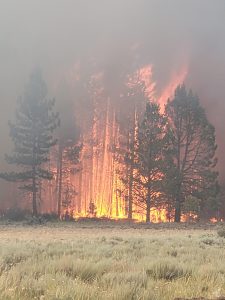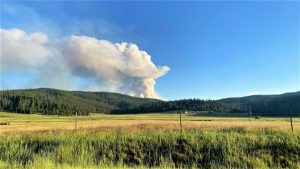Bighorn Basin: Where’s the Smoke Coming From?
Written by Andrew-Rossi on July 14, 2021
Thanks to a combination of large wildfires in Idaho and Oregon, the Bighorn Basin is likely to be covered in a dense smoke plume for the discernible future.
The skies of the Bighorn Basin continue to be hazy and full of smoke. With only one minor wildfire in Wyoming, it means the smoke is blowing in from fires elsewhere in the nation.
According to the National Weather Service Office in Riverton, the smoke is coming from fires in the Pacific Northwest. It first blew into Cody on Friday, July 9, and has persisted ever since.
Further examination reveals multiple fires – in Idaho and Oregon – that are darkening Cody’s skies. The Interagency Wildland Fire Air Quality Response Program has an updated Fire and Smoke Map, which shows where smoke originates and its affecting areas.
One of the fires contributing to the smoky haze of Cody is the Bootleg Fire – a massive wildfire burning national forests in south-central Oregon.
The Bootleg Fire was first reported on July 6 at approximately 1:42 p.m. in the Fremont and Winema National Forests in south-central Oregon. It has undergone “explosive growth” in the days since, previously doubling its size in a single day.
As of Tuesday, July 13, the Bootleg Fire is over 200,000 acres and 0% contained. The cause remains unknown.
1,189 personnel are currently on the scene of the Bootleg Fire, responding to the flames.
For comparison, the Robertson Draw Fire in Custer Gallatin National Forest has been contained to just under 30,000 acres. While the fire is still considered active, it is no longer sending a smoke plume in Wyoming.
Meanwhile, no less than five separate wildfires of varying sizes in Idaho are mostly responsible for the Bighorn Basin smoke.
InciWeb has incident pages for the following fires in Idaho that are sending smoke to Cody. The status of the major fires (as of Tuesday, June 13) are listed below:
- Mud Lick Fire – 5,263 acres
- Dixie and Jumbo Fires -19,109 acres
- Trail Creek Fire – 5,383 acres
Each of these “large fire incidents” in Idaho are 0% contained.
More Idaho fires are contributing to the smoke, but they are all relatively small at this point. For example, the Fritzer and Alder Creek Fires are less than 500 acres in size and may be absorbed into their voracious neighbors.
Given the size of these fires and containment levels, it seems the smoke enveloping the Bighorn Basin won’t be lifting anytime soon.
An Air Quality Alert has been in effect almost every morning this week due to the encroaching smoke from all these fires. While prolonged exposure can negatively affect anyone, certain people with health conditions should avoid any outdoor activities under the alert is lifted.
“The Wyoming Department of Health recommends that the elderly, young children and individuals with respiratory problems avoid excessive physical exertion and minimize outdoor activities during this time. Wildfire smoke is made up of a variety of pollutants, including particulate matter and ozone, which can cause respiratory health effects. Although these people are most susceptible to health impacts, the Department of Health also advises that everyone should avoid prolonged exposure to poor air quality conditions.”
The National Weather Service placed the entire Bighorn Basin was under a Red Flag Warning on Tuesday, July 13. Low humidity, strong winds, and severe thunderstorms “will create erratic fire behavior and new fire starts” over the course of the next week.



